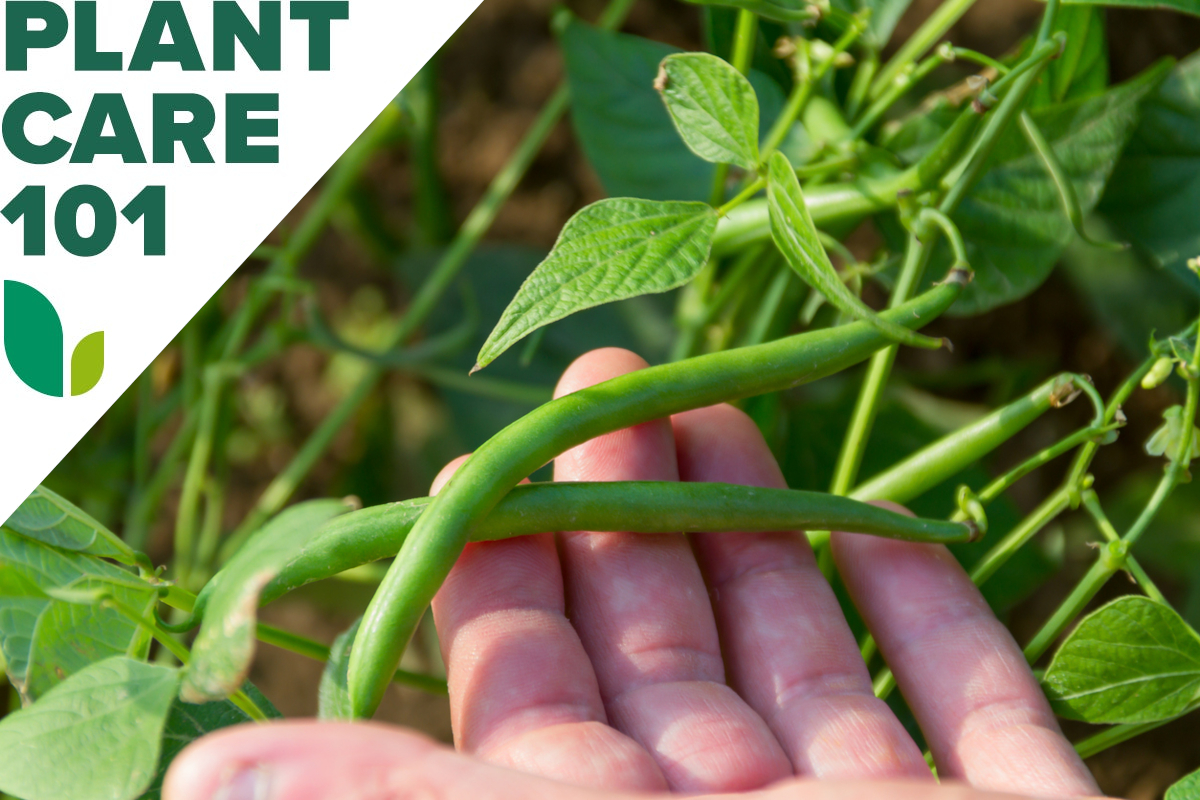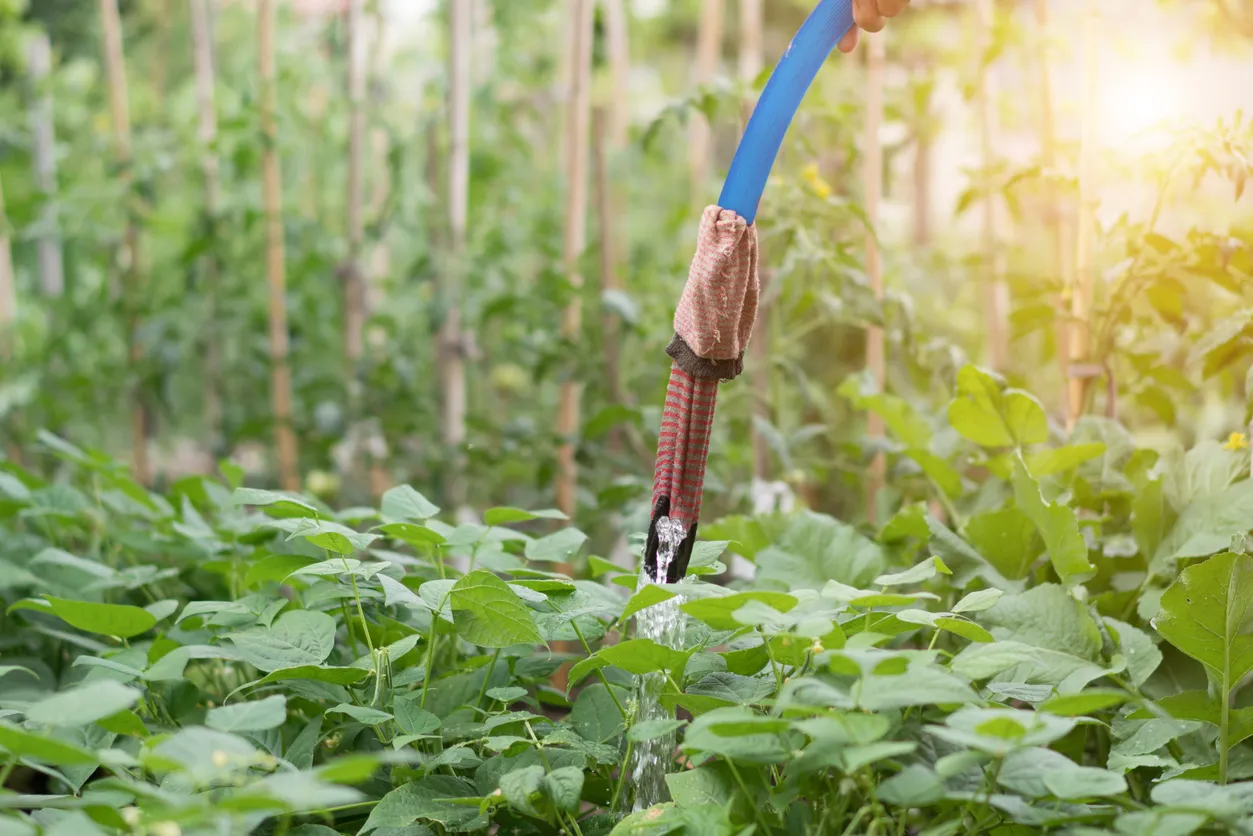

We may earn revenue from the products available on this page and participate in affiliate programs. Learn More ›
Among the easiest garden vegetables to grow, green beans—also known as string or snap beans—usually mature 50 to 70 days after you sow the seeds outdoors. Therefore, you can grow green bean plants even if you are late in getting your garden started. And you can sow them every 2 weeks all summer until August for a continuous harvest.
When considering how to grow green beans, keep in mind that they actually are the pods of bean seeds that aren’t allowed to mature. Therefore, if you leave them on the plant too long, they will make dry beans.
Growing Green Beans at a Glance
Common Name: Green bean, string bean, snap bean
Scientific Name: Phaseolus vulgaris, Phaseolus coccineus
Hardiness Zone: Annual or Zones 7 to 11
Soil: Well drained, pH 6 to 7
Light: Full or partial sun
Water: Average
Food: Low-nitrogen fertilizer
Propagation: Seed
Safety: Nontoxic
RELATED: 12 Climbing Vegetables That Are Perfect for Compact Gardens

Green Bean Characteristics
The most common bean, the annual bush type, grows 1 to 2 feet tall with heart shaped leaves, inconspicuous white- to pink-tinged white blooms, and green, yellow, or purple pods. They don’t require support and produce most of their harvest over a 3-week period.
As their name implies, annual pole beans—although similar in appearance to bush beans—are vining types that can climb to 6 feet or more on poles or trellises or on corn stalks in a Three Sisters garden. Although slower to set a crop than bush beans, they continue producing all summer.
Annual half-runner beans fall between the two previously mentioned varieties in height, generally topping off at about 3 feet. Tender perennial runner beans, which are hardy in USDA Zones 7 to 11, are similar to pole beans in habit. However, they often are grown solely for their showy red blooms, since their pods tend to be tough.
Recommended Green Bean Varieties
Plenty of heirloom and hybrid green bean varieties, including those below, offer some choice to gardeners. Be sure to check the online or seed packet information for time to maturity, favored conditions, preferred kitchen uses, and typical yield of green bean plants to help in your selection.
- Blue Lake 274: Developed from the Blue Lake heirloom pole bean in the 1960s, this bush bean stringless cultivar remains highly popular, sometimes producing a crop in less than 60 days.
- Kentucky Wonder: Called by Burpee “one of the most popular beans of all time and a favorite of American gardeners since the late 19th century,” this open-pollinated heirloom pole bean produces “thick, meaty” pods that only remain stringless when young, and matures in about 65 days.
- Mountaineer: Another open-pollinated heirloom, this half-runner bean from West Virginia can be grown without poles. It matures in 56 days.
- Scarlet Emperor: This open-pollinated runner bean reportedly climbs to 10 feet or more in 75 days with clusters of showy red blooms.
Planting Green Beans
Don’t start any of these types of beans indoors, unless you use biodegradable pots, since their roots are easily damaged during transplanting. Besides, they are such fast-growing vegetables that they don’t need a head start.
When is the best time to plant green beans?
Wait to sow beans until all danger of frost has passed and daytime temperatures have risen to between 65 and 85 degrees, with soil temperatures of at least 55 degrees, preferably 60 degrees. (The perennial runner bean can take a bit more cold, but no frost, with a soil temperature as low as 50 degrees.)
Where can green beans grow?
Choose a site with well-draining soil conditions and a pH between 6 and 7 in a spot that receives at least 6 hours of sunlight per day, though more will be better. Beans reportedly prefer loam or clay soils over sandy ones, but you should avoid positions where they grew the previous year. The New Sunset Western Garden Book notes that the “soil needn’t be particularly deep, since beans have shallow roots.”
How do you plant green beans?
Cornell University recommends that you refrain from presoaking bean seeds, which can damage them.
- Sow seeds of bush beans and half-runner beans 1 inch deep and 2 to 4 inches apart in rows spaced 2 to 3 feet apart.
- For pole beans, set up a teepee constructed of 6- to 8-foot poles bound together at the top before you plant the beans.
- Then sow them 1 inch deep and 4 to 6 inches apart, 2 to 3 inches deep and 4 to 8 inches apart for perennial runner beans.
Can you grow green beans in containers?
Because you will need a 10-foot row of bean plants to produce 3 to 4 pounds of beans, growing them in containers generally isn’t practical. However, you may be able to make it work, if you choose a large container and grow pole beans on a teepee or trellis in it, since they do most of their growing upward.
RELATED: 11 Plants You Should Never Start Indoors

Watering Green Bean Plants
Keep the beans’ soil damp but not soggy until they sprout, generally in 8 to 10 days, though they might take longer in cool soil. Once they have two true leaves in addition to their seed leaves, you can cut back on the watering a bit. Just ensure that the beans receive the equivalent of 1 inch of rainfall per week, preferably applied early in the morning so the foliage dries quickly. Once the beans have two sets of true leaves, mulch them with 3 to 4 inches of grass clippings or straw to maintain their moisture and discourage weeds.
Fertilizing Green Beans
Beans can set some of their own nitrogen, especially so if you treat the seeds with rhizobium bacteria before you sow them. Therefore, avoid high-nitrogen fertilizers, since an excess of the nutrient will cause lush plants with few pods. Instead, fertilize your green bean plot with a low-nitrogen organic fertilizer such as a 3-4-6 tomato fertilizer. Work 1½ pounds into every 25 square feet of soil before you plant your beans. Make another application once pods begin to appear.
Pollination
Beans don’t require bees or other insects for pollination. According to Montana State University “most types of beans have flowers that are self-pollinating, with most fertilization occurring before the flowers are even open.” Keep in mind, however, that sizzling temperatures (above 85 degrees Fahrenheit) can cause bean blossoms to abort without producing pods. So gardeners in the South and Southwest should avoid growing beans in the heat of summer or at least avoid types such as Blue Lake that are sensitive to sweltering conditions.
Safety Considerations
Green beans are edible either raw or cooked when tender, as are their flowers. However, if you accidentally make dry beans, be sure you cook those before eating them, since some, such as kidney beans, can be toxic when raw.
Also, as the University of Minnesota Extension cautions, “Home-canned beans are one of the most common sources of botulism poisoning.” Therefore, if you intend to preserve your green beans, either use a pressure canner to can them or freeze them instead.
Potential Pests and Diseases
Cutworms sometimes like to hug the stems of beans and chomp them off at ground level. Look for these pests, which tend to curl into a C shape, during the early evening and drop them into soapy water to kill them.
Bean leaf beetles, which are about ¼ inch long, in either greenish yellow or red hues with black spots, can riddle your plants with ⅛-inch holes. To outsmart them, determine when the overwintering adults emerge in your climate and when their offspring “hatch” and then plant your beans in the time period between those infestations to avoid the worst damage.
RELATED: Garden Wreckers: 13 Pests That Will Tear Your Plants Apart This Spring

Harvesting Green Beans
Once you know how to grow green beans, you can look forward to a summer harvest. About 6 weeks after you plant your beans, begin to check for pods on them, and then follow these tips for harvesting.
When is the best time to harvest green beans?
Rhoda Burrows of South Dakota State Extension advises that “Snap beans can be picked at any stage of pod formation until the shape of the individual seeds inside becomes apparent, causing the pods to bulge. After this stage, the pods are typically less juicy and more fibrous.” They generally are best if harvested when about the size of a 4- to 6-inch pencil.
How do you harvest green beans?
As was previously mentioned, you should pick your beans while they still look slender and svelte and before they start to bulge in all the wrong places!
- To prevent the spread of disease, pick your beans only when the plants are dry.
- When harvesting beans, pinch off each one just below the stem that attaches it to the plant, using both hands if possible to prevent breaking the stem.
- Pick your beans every 3 to 5 days to prevent them from going entirely to seed, which will stop their production.
How do you store green beans?
If you plan to cook or process your beans within a few hours, you can leave them out of the refrigerator. (Keep in mind that purple string beans naturally turn green when boiled.) Otherwise, keep them in a covered container inside that refrigerator for up to 4 days. Should you decide to freeze them, you will need to blanch them first.
Looking for more beginner-friendly vegetables? Check out our guides on growing corn, cucumber, and kale.
